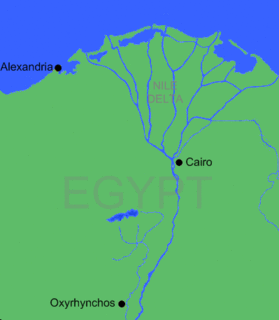Papyrus Oxyrhynchus 55 is a request for payment for the construction of a street, written in Greek. The manuscript was written on papyrus in the form of a sheet. It was discovered by Grenfell and Hunt in 1897 in Oxyrhynchus. The document was written on 7 April 283. It is housed in the Cambridge University Library. The text was published by Grenfell and Hunt in 1898.
Papyrus Oxyrhynchus 57 is a letter relating to a peculation by a treasury official, written in Greek. The manuscript was written on papyrus in the form of a sheet. It was discovered by Grenfell and Hunt in 1897 in Oxyrhynchus. The document was written between 195-196 CE. It is housed at Johns Hopkins University. The text was published by Grenfell and Hunt in 1898.
Papyrus Oxyrhynchus 61 is a notice of the payment of a fine, written in Greek. The manuscript was written on papyrus in the form of a sheet. It was discovered by Grenfell and Hunt in 1897 in Oxyrhynchus. The document was written on 18 November 221. Currently it is housed in the Cambridge University Library in Cambridge. The text was published by Grenfell and Hunt in 1898.
Papyrus Oxyrhynchus 88 is an order for payment of wheat, written in Greek. The manuscript was written on papyrus in the form of a sheet. It was discovered in Oxyrhynchus. The document was written on 31 October 179. Currently it is housed in the University Museum of the University of Pennsylvania in Philadelphia.
Papyrus Oxyrhynchus 92 is an order for payment, written in Greek. The manuscript was written on papyrus in the form of a sheet. It was discovered in Oxyrhynchus. The document was written on 15 October 336. Currently it is housed in the Houghton Library of the Harvard University in Cambridge.
Papyrus Oxyrhynchus 93 is an order for payment, written in Greek. The manuscript was written on papyrus in the form of a sheet. It was discovered in Oxyrhynchus. The document was written on 16 January 362. Currently it is housed in the British Museum (762) in London.
Papyrus Oxyrhynchus 96 is an order concerning payment of sales tax, written in Greek. It was discovered in Oxyrhynchus. The manuscript was written on papyrus in the form of a sheet. The document was written on 5 November 180. Currently it is housed in the Cambridge University Library in Cambridge.
Papyrus Oxyrhynchus 98 is a letter acknowledging the repayment of a loan, written in Greek. It was discovered in Oxyrhynchus. The manuscript was written on papyrus in the form of a sheet. It is dated to between 141 and 142. Currently it is housed in the British Museum (764) in London. It is also known as P. Lond. III 764.
Papyrus Oxyrhynchus 99 concerns the sale of half a house, written in Greek. It was discovered in Oxyrhynchus. The manuscript was written on papyrus in the form of a sheet The document was written on 4 September 55. Currently it is housed at the British Museum (756) in London.
Papyrus Oxyrhynchus 104 is a will, written in Greek and discovered in Oxyrhynchus. The manuscript was written on papyrus in the form of a sheet. The document was written on 26 December 96. Currently it is housed in the Cambridge University Library.
Papyrus Oxyrhynchus 112 is an invitation to a festival, written in Greek and discovered in Oxyrhynchus. The manuscript was written on papyrus in the form of a sheet. The document was written in the late 3rd or early 4th century. Currently it is housed in the Vaughan Library at the Harrow School in Harrow on the Hill.
Papyrus Oxyrhynchus 145 is a receipt, written in Greek and discovered in Oxyrhynchus. The manuscript was written on papyrus in the form of a sheet. The document was written on 15 March 552. Currently it is housed in the Egyptian Museum (10066) in Cairo.
Papyrus Oxyrhynchus 146 is a receipt, written in Greek and discovered in Oxyrhynchus. The manuscript was written on papyrus in the form of a sheet. The document was written on 15 November 555. Currently it is housed in the Egyptian Museum (10076) in Cairo.
Papyrus Oxyrhynchus 147 is a receipt, written in Greek and discovered in Oxyrhynchus. The manuscript was written on papyrus in the form of a sheet. The document was written on 7 April 556. Currently it is housed in the Egyptian Museum (10074) in Cairo.
Papyrus Oxyrhynchus 148 is a receipt, written in Greek and discovered in Oxyrhynchus. The manuscript was written on papyrus in the form of a sheet. The document was written on 12 April 556. Currently it is housed in the Egyptian Museum (10075) in Cairo.
Papyrus Oxyrhynchus 150 is a receipt, written in Greek and discovered in Oxyrhynchus. The manuscript was written on papyrus in the form of a sheet. The document was written on 7 October 590. Currently it is housed in the Egyptian Museum (10051) in Cairo.
Papyrus Oxyrhynchus 154 is an account listing various payments, written in Greek and discovered in Oxyrhynchus. The manuscript was written on papyrus in the form of a sheet. The document was written in the late 6th century. Currently it is housed in the Egyptian Museum (10102) in Cairo.
Papyrus Oxyrhynchus 237 consists of a fragment of Petition of Dionysia to the Praefect, written in Greek. They were discovered in Oxyrhynchus. The manuscript was written on papyrus in the form of a roll. It was written after 27 June 186. Currently it is housed in the Bodleian Library.




